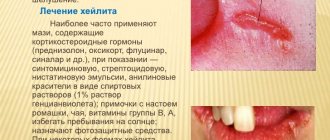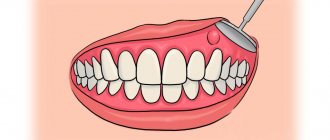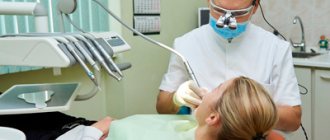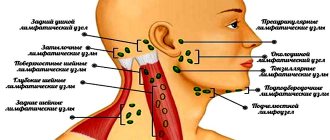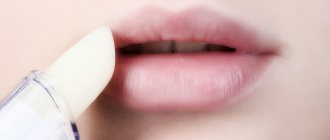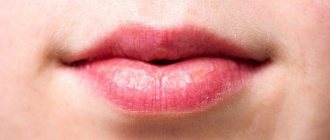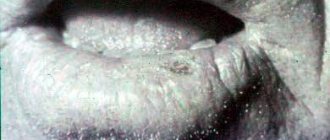Exfoliative cheilitis is an inflammation of the lips, and only the border of the lips is affected, becoming bright red, painful and irritated. To date, there is no consensus regarding the origin of the disease. Most researchers tend to believe that the cause of its occurrence is a combination of neurogenic factors. According to statistics, the majority of patients diagnosed with exfoliative cheilitis are women between twenty and forty years old.
Many patients suffering from exfoliative cheilitis have a history of psycho-emotional disorders. A significant percentage of cases are associated with depressive states, neuroses and autonomic dysfunctions. Among the provoking factors there are also immunological, endocrine and hereditary predisposition factors.
The disease has no tendency to remission or self-healing, assumes a long course and can transform over time from one form to another.
What it is
Chronic damage to the red border of the lips, in which peeling and irritation does not spread to the surrounding tissues, is called exfoliative cheilitis. Women of childbearing age are most susceptible to this disease.
Doctors distinguish two forms of exfoliative cheilitis:
- The dry form is accompanied by chronic dry lips, peeling, and sometimes itching and burning. Often, hyperemia begins between the mucous and red border, resulting in the formation of a dense strip consisting of transparent scales at this border. When this layer is surgically removed, the unprotected surface of the rich red mucosa is exposed. Most often it is smooth to the touch, but it may develop shallow ulcerations or bumps.
- The exudative form differs from the dry form by sharply enlarged, swollen, hyperemic lips. The patient cannot close his mouth completely due to pain, as a result of which his lips are constantly parted. This form of exfoliative cheilitis got its name due to the constant release of exudate, which gradually dries out and forms massive crusts. In most cases, they are quite easy to remove, but sometimes the exudate and scales can grow together, forming a continuous layer hanging down to the chin.
Not all patients believe that the dry form requires treatment in the same way as the exudative one, as a result of which the disease quickly becomes chronic and can last for many years. In addition, both forms of the disease can transform into one another, but very rarely spontaneous recovery occurs. Some people mistakenly consider this type of disease to be precancerous.
How the problem manifests itself
HC “announces itself” with classic symptoms - characteristic red dots appear on the border of the lips (seen in the photo above). These are nothing more than the mouths of the salivary glands affected by the disease. If you blot your lips, after a short period of time droplets of secretion will appear on them again. Due to the fact that saliva is produced in excess of normal, the surface of the lips is constantly moisturized. But due to the constant evaporation of liquid, the skin, accustomed to “humidity,” cracks and flakes.
Secondary GC is a complication of skin diseases, pathological processes in the oral cavity, the result of smoking and neglect of the rules of caring for teeth and gums
In some patients, the course of HC is associated with constant itching in the affected area. At the same time, the “affected” skin looks rough, unhealthy, the epithelium becomes keratinized and dry. White ring-shaped formations often appear around the mouths of the salivary glands - these are foci of leukoplakia. The purulent form of cheilitis most typically manifests itself. Thus, the lips swell, become extremely sensitive to any mechanical damage, and are very painful.
On examination, the skin looks red, swollen, thinned, flaky, the epithelium is covered with multiple purulent crusts. Upon palpation, enlarged, compacted salivary glands are determined, when pressed, a secretion mixed with purulent exudate is released. In the complicated course of Volkmann's cheilitis, local signs of inflammation are accompanied by symptoms of general intoxication of the body, enlargement of the submandibular lymph nodes, and abscess formation of the lips.
Causes
According to research results, the main cause of the development of exfoliative cheilitis is a disruption of the central nervous system, accompanied by depression, nervous exhaustion, apathy, phobias and other psychosomatic reactions. In addition, some doctors share the view that genetic abnormalities and systemic allergic reactions are involved in the development of this disease. The possibility of a sharp decrease in immunity cannot be ruled out.
In some patients, this type of cheilitis occurs due to problems with the thyroid gland. Another suspected reason is an increase in the permeability of capillary walls. However, the pathogenesis and etiology of exfoliative cheilitis are still not fully understood.
Treatment results
Under the influence of the therapy, it was possible to achieve regression of AC symptoms in most patients, while improving skin trophism. The topical glucocorticosteroids used quickly stopped the exacerbation of AC.
The children were under observation throughout the treatment period. The result of therapy was assessed as good when all symptoms of AC disappeared or were significantly weakened; as satisfactory – with slight improvement; as negative – in the absence of treatment effect. A good effect from treatment with external therapy was achieved by 62 (62%) patients, a satisfactory effect by 31 (31%), and no effect was observed in 7 (7%) children.
Thus, when treated with the external therapy presented above, the majority of children with AC managed to reduce hyperemia, peeling of the KKG and skin of the perioral area, as well as ensure a decrease in skin lichenification and healing of cracks.
Clinical improvement of the atopic process on the lips during treatment with external agents occurred on the 2-3rd day of treatment. The dynamics of clinical manifestations of AC during therapy are presented in the figure.
The duration of remission of the isolated form of AC was on average 4–6 months, and remission of AC against the background of AD was 2–3 months.
The dentist should consider the symptoms of AC, perioral dermatitis, and cracked oral commissures in children as possible manifestations of an allergic process. It is necessary to recommend that parents contact a pediatrician and allergist to have their child examined.
Symptoms
The main signs of exfoliative cheilitis are dryness, flaking and itching that do not extend beyond the red line of the lips. The mucous membrane of the oral cavity, the corners of the lips and the skin around them are not affected. The main manifestation of the dry form is the formation of scales, which the patient most often simply bites off, not attaching importance to the disease and without consulting a doctor. After removing the scales, a red, hyperemic surface remains, on which scales form again within a week.
In the exudative form, the symptoms are characterized by the presence of pain, the formation of gray and brownish crusts of scales and dried exudate, which complicate eating and communication.
Prognosis and prevention
With timely treatment and the absence of malignancy processes, the prognosis is almost always favorable. If the therapy has caused noticeable cosmetic defects, you can resort to methods for correcting the appearance of the lips.
To prevent complications, it is important to understand whether you are at risk. The presence of allergic diseases and dermatoses, chronic endocrine diseases, and wearing dentures increase the risk of developing pathology. To prevent the appearance of cheilitis, it is important to adhere to several rules:
- regularly visit the dentist, sanitize the oral cavity, remove tartar;
- promptly replace outdated fillings and orthopedic structures, contact after chipped teeth and injuries to prevent lip injury from the sharp edges of fillings and enamel;
- For the manufacture of prostheses, contact only professionals;
- eat properly and nutritiously to prevent hypovitaminosis;
- try to avoid prolonged exposure to the sun and use products with SPF, including for lips;
- be attentive to your health and promptly treat diseases of the gastrointestinal tract, endocrine, nervous system, and internal organs.
Diagnostics
To make a correct diagnosis, the doctor must be able to distinguish the manifestations of exfoliative cheilitis from other types (eczematous, actinic, contact, atopic), as well as from the symptomatic picture of lupus erythematosus. Unlike all of the listed diseases, this type of lesion is not accompanied by the formation of blisters, erosions, cracks, scars and other lesions, with the exception of those listed above, and does not spread beyond a certain part of the red border of the lips. The transition of this type of cheilitis to others is also not noted; only an internal transition from one form to another is possible.
Causes of the disease
Primary HC is a consequence of congenital pathology of the salivary glands. So, if parents are faced with such a problem, the likelihood that HC will occur in children is almost 100%. It is noteworthy that the initial symptoms of congenital glandular cheilitis appear only after 20 years (the salivary glands increase in size, the amount of secretion they produce increases).
Secondary GC is a complication of the following diseases:
- lupus erythematosus;
- leukoplakia;
- lichen planus.
Constant irritation of the “local” mucosa, which accompanies the course of these ailments, leads to the proliferation of glandular tissue and increased secretion production. The risk of secondary cheilitis increases with chronic diseases of the skin and oral mucosa - periodontitis, periodontal disease, inflammation of the lip mucosa. HC can be caused by the presence of diseased teeth with sharp edges or incorrectly fixed (size-fitted) dentures.
Important! With abnormal expansion of the ducts of the salivary glands, there is a possibility of subsequent infection of them, this, in turn, leads to purulent HC (Folman's cheilitis).
Treatment
If you are diagnosed with exfoliative cheilitis, treatment should be comprehensive. The prescription of drugs will depend directly on the probable cause of the disease. The psycho-emotional cause involves treatment with antipsychotics, antidepressants and even tranquilizers. In addition, the patient needs to seek professional help from a neuropsychiatrist.
To eliminate scales, crusts and itching, it is recommended to constantly lubricate your lips with oil solutions, creams or hygienic lipstick. If you have other symptoms (dizziness, lump in the throat, shaking hands, dry mouth), it is recommended to get tested for thyroid hormones and begin appropriate treatment.
Among other things, immunocorrection and the use of vitamin-mineral complexes would be useful. In difficult cases, the doctor may prescribe local administration of hormonal drugs through ultrasound or laser therapy. With long-term treatment, the exudative form can turn into dry.
Treatment of exfoliative cheilitis
Treatment of exfoliative cheilitis involves, first of all, influencing the factors that provoked it. Since cheilitis is one of the diseases associated with the patient’s psycho-emotional state, a consultation with a neurologist is often required, who can prescribe sedatives or antidepressants. If the disease occurs due to thyroid dysfunction, you will need to consult an endocrinologist.
Treatment may also include acupuncture, removal of keratinized crusts on the lips with a solution of boric acid, and in children, the use of a moisturizer.
The disease is not prone to self-healing, so it is necessary to find the cause of the disease and carry out all treatment measures in a timely manner.
Prevention
Since it is impossible to predict the development of exfoliative cheilitis, the only means of prevention will be oral hygiene, proper nutrition, a healthy lifestyle, giving up bad habits and taking a course of vitamins in the autumn-winter period. It is necessary to carefully monitor the immune system and take timely measures to restore it. Also, do not overuse lipsticks containing lanolin, as it clogs pores, dries out lips and often causes an allergic reaction.
Cheilitis [seizures, cracks, erosions, “fever”, inflammation on the lips]
Causes
As noted above, cheilitis is a collection of etiologically heterogeneous diseases, and in each case the causes should be considered separately.
Simple (meteorological, actinic, catarrhal) cheilitis occurs in unfavorable conditions for humans, primarily in strong winds (both hot and frosty), in dusty air, as well as under intense solar radiation with its harmful ultraviolet spectrum component. Possible causes also include mechanical, chemical, thermal and radiation injuries. This type of cheilitis (or rather, several of its subtypes are included here for brevity) is more common among men, at least those who do not wear lipstick.
Allergic cheilitis occurs almost exclusively in women and is caused by individual hypersensitivity to organic or inorganic compounds, physical factors, and occupational hazards. The eczematous type of cheilitis is caused by similar reasons.
Exfoliative cheilitis, perhaps, should be divided not into two main clinical forms (dry and exudative), but into several independent diseases, since this polyetiological type of cheilitis can be caused by endocrine, neuropsychic, immune, and hereditary factors.
Glandular cheilitis is a disease of the system of small salivary glands located along the vermilion border of the lips and in the border border.
The causes are congenital and acquired hyperplasia, various types of dysfunction, infections, etc. 4-6% of adults suffer, twice as often as men than women.
A special form can be considered abrasive pre-cancerous Manganotti cheilitis, caused mainly by presenile and senile degenerative-dystrophic changes; A distinctive feature of this form is a very high probability of malignant degeneration. Manganotti's precancerous cheilitis also affects predominantly men.
In general, in order not to go into too detailed classifications for this article, we will highlight the most common causes and significant risk factors:
- hypo- and vitamin deficiency;
- allergic predisposition;
- any factors that suppress or weaken the immune defense;
- infections, incl. bacterial nonspecific (most often staphylococci and streptococci) and specific (tuberculosis, syphilis); viral (eg, herpes); fungal (widespread yeast fungus of the genus Candida). This implies the pathogenetic role of such factors as lack of personal hygiene, the use of other people’s oral and facial skin care products, as well as oral sex, incl. kisses;
- constant trauma to the lips - chipped, decaying teeth, incorrectly fitted dentures, tobacco smoke, the habit of biting lips, and many others;
- the presence of one of dermatoses, neurodermatitis, eczema, psoriasis, lichen ruber, atopic dermatitis, AIDS, hepatitis, anemia, diabetes mellitus and other serious chronic diseases.
Eczematous cheilitis
Eczematous cheilitis manifests itself under the influence of allergic factors. Most often it happens for cosmetics. Predisposing factors include chronic lip injury and a lack of B vitamins.
Manifestations: Congestive hyperemia, infiltration, the presence of fever-like elements are observed, and seizures may also occur in the corners of the mouth. The lips are covered with crusts. The skin around the lips also suffers, it becomes wet, it peels and burns.
Treatment: All treatment is based on antiseptic treatment of the lips, taking multivitamins, as well as the use of corticosteroid ointments. And first of all, it is natural to eliminate unfavorable factors, that is, the causes.

